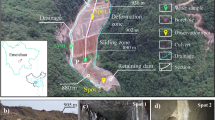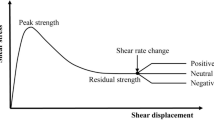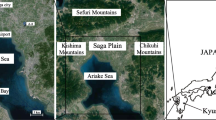Abstract
The production of runoff in the source area of a debris flow is the consequence of a reduction in soil strength. Gravel soil is widely distributed in the source region, and the influence of its clay content on soil strength is one of the important questions regarding the formation mechanism of debris flows. In this paper, the clay content in gravel soil is divided into groups of low clay content (1%, 2, 5%), moderate clay content (3.75%, 5.00%, 6.25%, 7.5%) and high clay content (10.0%, 12.5%, 15%). Tests of the unconsolidated undrained shear strength and consolidated drained shear strength were performed. The unconsolidated undrained shearing (UU) experiment simulates the rapid shear failure of loose gravel soil under the conditions of brief heavy rainfall. The consolidated drained shearing (CD) experiment simulates creep failure of consolidated sediment during extended rainfall. The pore water pressure first increased and then decreased as the clay content increased, and the increase in pore pressure was relatively high in the gravel soil sample when the clay content is in the range of 3.25-7.50%, and stress in the gravel soil is relatively low for a moderate clay content. Gravelly soils with a moderate clay content are more prone to debris-flow initiation. This paper presents a mathematical formula for the maximum shear stress and clay content of gravel soil under two conditions. The key processes whereby the soil fails and triggers a debris flow—volume contraction of soil, expansion of clay soil, and rise of pore pressure—cause reductions in the soil friction force and enhancement of the water content in the clay particles, and subsurface erosion of soil reduces the soil viscosity, which eventually reduces the soil strength so that the soil loses its stability, liquefies and generates a debris flow.
Similar content being viewed by others
References
Cannon SH (2000) Debris flow response of southern California watersheds burned by wildfire. In: Wieczorec, GF, Naeser ND (Eds.), Debris Flow Hazards Mitigation: Mechanics. Prediction and Assessment, Balkema, Rotterdam, pp. 45–52.
Chen NS, Cui P, Chen R, He Y, et al. (2002) The distribution and characteristics of debris flows along Sino–Nepal highway. Journal of Geological Hazard and Control 13(1): 44–48. (In Chinese)
Chen NS, Gao YC, Li DF (2003) Survey report on July 11, 2003 debris flow in Danba county, Sichuan province. Journal of Mountain Research 21(5): 632. (In Chinese)
Chen NS, Zhou W, Yang CL, et al. (2010) The processes and mechanism of failure and debris flow initiation for gravel soil with different clay content. Geomorphology 121(3–4): 222–230. https://doi.org/10.1016/j.geomorph.2010.04.017
Chen NS, Zhu YH, Huang Q, et al. (2017) Mechanisms involved in triggering debris flows within a cohesive gravel soil mass on a slope: a case in SW China. Journal of Mountain Science 14(4): 611–620. https://doi.org/10.1007/s11629-016-3882-x
Chen NS, Lu Y, Zhou HB, et al. (2014) Combined impacts of antecedent earthquakes and droughts on disastrous debris flows. Journal of Mountain Science 11(6): 1507–1520. https://doi.org/10.1007/s11629-014-3080-7
Coussot P, Meunier M (1996) Recognition, classification and mechanical description of debris flows. Earth Science Reviews 40: 209–227. https://doi.org/10.1016/0012-8252(95)00065-8
Cui P (1992) Study on condition and mechanisms of debris flow initiation by means of experiment. Chinese Science Bulletin 37(9): 759–763. (In Chinese)
Cui P, Guan J (1993) The sudden change properties of debris flow initiation. Journal of natural disasters 2(1): 53–61.(In Chinese)
Dolinar B, Trauner L (2007) The impact of structure on the undrained shear strength of cohesive soils. Engineering Geology 92: 88–96. https://doi.org/10.1016/j.enggeo.2007.04.003
Ellen SD, Fleming RW (1987) Mobilization of debris flows from soil slips, San Francisco Bay region, California. Debris F10ws/Avalanches: Process, Recognition, and Mitigation. Geological Society of America, Boulder, CO: 31–40. https://doi.org/10.1130/REG7-p31
Federico F, Cesali C (2015) An energy–based approach to predict debris flow mobility and analyze empirical relationships. Canadian Geotechnical Journal 52 (12): 2113–2133. https://doi.org/10.1139/cgj-2015-0107
Federico F, Cesali C (2017) Coupled effects of pore water pressures evolution, slope curvature and mass variation on the kinematics of rapidly sliding fine–grained materials. International Journal of Geomechanics (ASCE) 17: 10. https://doi.org/10.1061/(ASCE)GM.1943-5622.0000976
Hutchinson JN (1986) A sliding consolidation model for flow slides. Canadian Geotechnical Journal 23(2): 115–126. https://doi.org/10.1139/t86-021
Hutchinson JN, Bhandari RK (1971) Undrained loading, a fundamental mechanism of mudflows and other mass movements. Géotechnique 21(4): 353–358. https://doi.org/10.1680/geot.1971.21.4.353
Institute of Mountain Hazards and Environment, Chinese Academy of Sciences, 2000. Debris Flows in China. The Commercial Press, Beijing: 60–69. (In Chinese)
Iverson, Richard M, LaHusen Richard G (1989) Dynamic porepressure fluctuations in rapidly shearing granular materials. Science 246: 796–799. https://doi.org/10.1126/science.246.4931.796
Iverson RM, Denlinger R, LaHusen R, et al. (2000) Two–phase debris–flow across 3–D terrain: model predictions and experimental tests. Debris–flow hazards mitigation: mechanics, prediction, and assessment. IOS Press: 521–529.
Iverson RM (2014) Debris flows: behaviour and hazard assessment. Geology today 30(1): 15–20. https://doi.org/10.1111/gto.12037
Major JJ (2000) Gravity–driven consolidation of granular slurries–Implications for debris–flow deposition and deposit characteristics. Journal of Sedimentary Research 70(1): 64–83. https://doi.org/10.1306/2DC408FF-0E47-11D7-8643000102C1865D
Musso A, Federico F, Troiano G (2004) A mechanism of pore pressure accumulation in rapidly sliding submerged porous blocks. Computers and Geotechnics 31(3): 209–226. https://doi.org/10.1016/j.compgeo.2004.02.001
Pérez FL (2001) Matrix granulometry of catastrophic debris flows (December 1999) in central coastal Venezuela. Catena 45(3): 163–183. https://doi.org/10.1016/S0341-8162(01)00149-7
Pierson TC (1981) Dominant particle support mechanisms in debris flows at Mt Thomas, New Zealand, and implications for flow mobility. Sedimentology 28(1): 49–60. https://doi.org/10.1111/j.1365-3091.1981.tb01662.x
Pierson TC, Costa JE (1987) A rheologic classification of subareal sediment flows. Reviews in Engineering Geology, VII Debris flow /Avalanches: process, recognition and mitigation, J.E. Costa &Wieczoreckeds, Geolocical Society of America, Boulder, Colorado 7:1–12. https://doi.org/10.1130/REG7-p1
Sassa K, Wang G (2005) Mechanism of landslide–triggered debris flows: Liquefaction phenomena due to the undrained loading of torrent deposits. Debris–flow hazards and related phenomena. Springer Press: 81–104.
Scott K (2000) Precipitation–triggered debris flow at Casita Volcano, Nicaragua: implications for mitigation strategies in volcanic and tectonically active steeplands. Debris–flow hazards mitigation: mechanics, prediction and assessment. AA Balkema Press, Rotterdam: 3–13.
Takahashi T (1978) The occurrence and flow mechanism of debris flow. Soil Mechanics and Foundation Engineering 26(6): 45–50. (In Japanese)
Wang GH, Kyoji S (2003) Pore–pressure generation and movement of rainfall–induced landslides: Effects of grain size and fine–particle content. Engineering Geology 69(1–2): 109–125. https://doi.org/10.1016/S0013-7952(02)00268-5
Wei HZ (2008) Mechanical behavior of gravelly soil and analysis initiation of debris–flows in Jiangjia Ravine. Ph.D Dissertation, Chinese Academy of Sciences, Wuhan, China. (In Chinese)
Wu JS, Kang ZC, Tian LQ, et al. (1990) Observation and research of debris flow in Jiangjiagou Ravine, Yunnan Province. Science Pressing, Beijing: 67–145. (In Chinese)
Acknowledgements
This study was supported by the National Natural Science Foundation of China (Grant Nos. 41501012 and 41502337) and the China Geological Survey (Grant No. 121201010000150003). The authors would like to express our heartfelt gratitude to the reviewers and editors who made valuable suggestions and helped us improve the content and presentation of the manuscript.
Author information
Authors and Affiliations
Corresponding author
Rights and permissions
About this article
Cite this article
Chen, Ns., Gao, Yc., Yang, Cl. et al. Effect of clay content to the strength of gravel soil in the source region of debris flow. J. Mt. Sci. 15, 2320–2334 (2018). https://doi.org/10.1007/s11629-018-4911-8
Received:
Revised:
Accepted:
Published:
Issue Date:
DOI: https://doi.org/10.1007/s11629-018-4911-8




